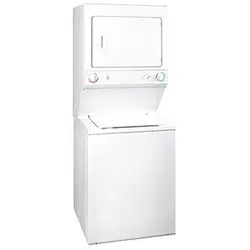Documents: Go to download!
User Manual
- User Manual - (English, French)
- User Manual - (French)
- Installation Instructions - (English)
- Energy Guide - (English)
- Energy Guide - (French)
- Washing Procedures
- Stain Removal
- Common Washing Problems
- Drying Procedures
- Features
- Common Drying Problems
- Care and Cleaning
- Avoid Service Checklist
Table of contents
Owners' Guide Washers and Dryers
Washing Procedures
- Follow the guidelines below for preparing the wash load.
- Read the Washer Operating Instructions for operating your specific model.
- Always read and follow fabric care and laundry product labels.
WARNING: To reduce the risk of fire, electrical shock, or injury to persons, read Important Safety Instructions before operating this washer.
- Sort laundry into loads that can be washed together.
Sort items by recommended water temperatures, wash time, and agitate/ spin speeds.
• Separate white, light, and colorfast items from dark and noncolorfast items.
• Separate items which shed lint from items which attract lint. Permanent press, synthetic, knit and corduroy items will pick up lint from towels, rugs and chenille bedspreads.
• Separate heavily soiled items from lightly soiled items.
• Separate lacy, sheer and loosely knit items from sturdy items
See other models: GLHS268ZDS FRT18G6JW GLRS263ZDQ GLFH17F8HB FFBC46F5LS
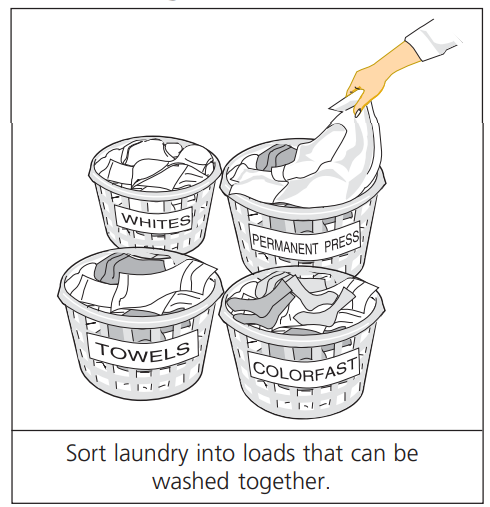
- Prepare items for washing.
• Empty pockets.

• Brush off lint and dirt. Shake out rugs and beach towels.
• Close zippers, fasten hooks, tie strings and sashes, and remove nonwashable trims and ornaments.
• Remove pins, decorative buttons, belt buckles, and other objects which could be damaged. This also helps protect other items in the wash load.
• Mend rips and tears to prevent further damage during washing.
• Place delicate items such as bras, shoulder pads, hosiery, and belts in a mesh bag to prevent tangling during the wash cycle.
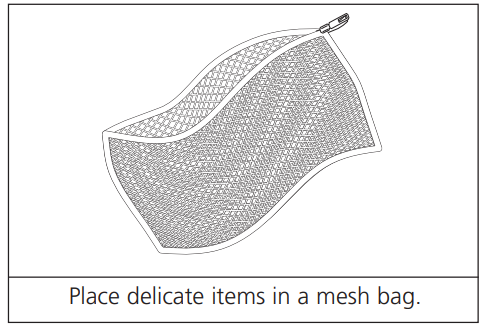
• Turn knit items inside out to prevent pilling. - Pretreat stains and heavy soil. See Stain Removal for details.
- Add a measured amount of detergent to the wash tub before adding the laundry load. Follow detergent manufacturer's directions. The amount required depends on type of detergent, load size and soil level, and water hardness.
- If desired, add liquid bleach to Bleach Dispenser (some models).
• Before adding the wash load, add liquid bleach to bleach dispenser located in left front corner under the lid:
- 3/4 cup (180 ml) for small loads
- 1 cup (240 ml) for large loads
- 1-1/4 cups (300 ml) for extra-large loads.
• Then add 1 cup (240 ml) water to flush the dispenser.
• Do not use powdered bleach in the bleach dispenser.
For models without a bleach dispenser, dilute the recommended amount of liquid chlorine bleach in 1 quart (.95 L) water. Add it to wash water after a few minutes of agitation. Do not pour bleach directly on wash load.
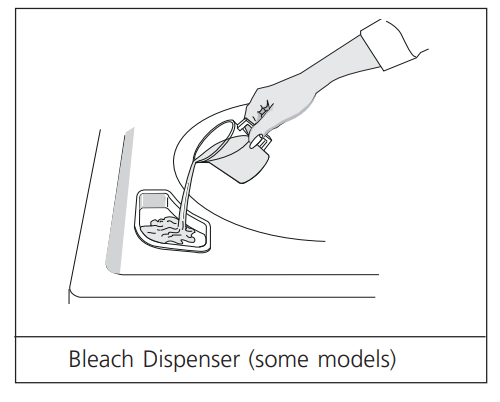
Washing Procedures con't - Add laundry load to washer.
• Dry load level should not be higher than the top of agitator vanes. Do not overload the washer.
• Do not put items on top of agitator or wrap them around it. Load items evenly.
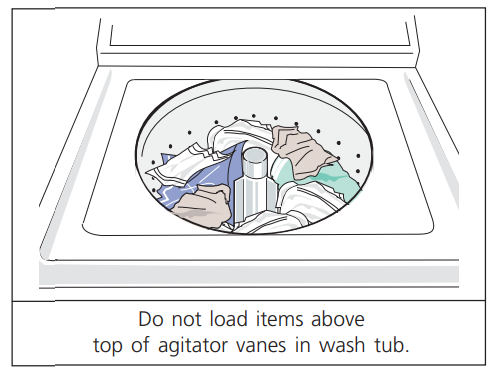
• Combine large and small items in a load. Load large items first. Large items should not be more than half the total wash load.
• When washing a single heavy item, add 1 or 2 towels to balance the load. - If desired, add liquid fabric softener to Fabric Softener Dispenser (available on some models). For models with a built-in dispenser (see picture to the left):
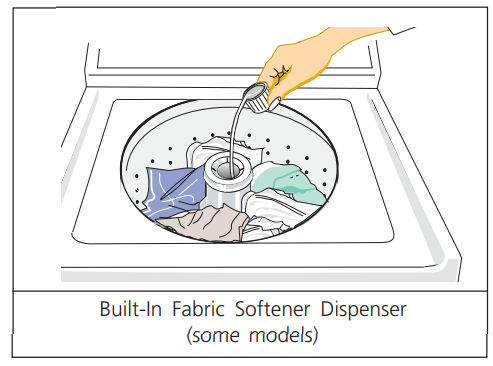
1. Add liquid softener to the dispenser, following fabric softener label directions.
2. Add water to bring liquid level to fill line on dispenser cap.
3. Remove the dispenser from the agitator after each use. Rinse both cap and cup with warm water. Replace dispenser in the agitator.
NOTE: To separate cap from cup, put thumb into dispenser and push against side of cup (see picture to the left). After cleaning, push cap and cup firmly together. Replace dispenser by lining up the ribs and grooves and snapping it into position. If fabric softener builds up in or around the dispenser, clean the area with hot water.
DO NOT REMOVE SERVICE CAP FOUND INSIDE THE AGITATOR POST.

For models without a fabric softener dispenser, follow fabric softener label directions. Add diluted fabric softener to the final rinse. Do not pour fabric softener directly on the wash load. - Select cycle and settings according to type, size, and soil level of each load See Operating Instructions for your specific model controls.
- Start the washer.
Close the washer lid and pull out the cycle selector knob. The washer will not fill with water, agitate or spin with the lid open.
• To stop the washer, push in the cycle selector knob.
• To change a cycle, push in the cycle selector knob. Turn it clockwise to the desired setting. Pull out the knob to restart the washer. - Remove items when the cycle is completed.
For your safety, the lid locks when the tub is spinning. It will remain locked for 2-3 minutes after the tub stops spinning.

• To open the lid during a spin, push in the cycle selector knob and wait about 2-3 minutes for the lid lock to release. Do not force open the locked lid.
Place washed items in automatic dryer, line dry, or dry flat as directed by fabric care label. Excess wrinkling, color transfer or odors may develop in items left in the washer after the cycle has ended.
WARNING: To avoid serious personal injury, do not operate washer if safety lid lock is missing or damaged.
Stain Removal
Safe Stain Removal Procedures
WARNING: To reduce the risk of fire, electrical shock, or serious injury to persons or property, comply with the basic warnings listed in Important Safety Instructions and those listed below.
- Read and comply with all instructions on stain removal products.
- Keep products in their original labeled containers and out of children's reach. • Thoroughly wash any utensil used.
- Do not combine stain removal products, especially ammonia and chlorine bleach. Dangerous fumes may result.
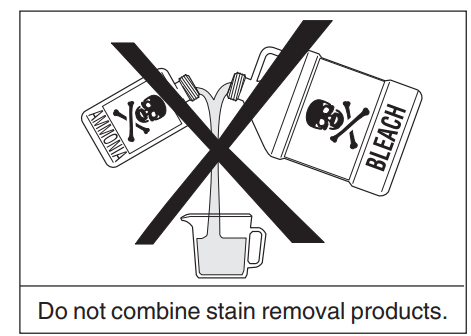
- Never wash items which have been previously cleaned in, washed in, soaked in or spotted with gasoline, dry cleaning solvents or other flammable or explosive substances because they give off vapors that could ignite or explode.
- Never use highly flammable solvents, such as gasoline, inside the home. Vapors can explode on contact with flames or sparks.
For successful stain removal:
- Remove stains promptly.
- Determine the kind of stain, then follow recommended treatment in the stain removal chart on the next page.
- To pretreat stains, use a prewash product, liquid detergent, or a paste made from granular detergent and water.
- Use cold water on unknown stains because hot water can set stains.
- Check care label instructions for treatments to avoid on specific fabrics.

- Check for colorfastness by testing stain remover on an inside seam.
- Rinse and wash items after stain removal.
| STAIN | TREATMENT |
| Adhesive tape, chewing gum, rubber cement | Apply ice. Scrape off excess. Place stain face down on paper towels. Saturate with prewash stain remover or nonflammable dry cleaning fluid. |
| Baby formula, dairy products, egg | Use product containing enzymes to pretreat or soak stains. Soak for 30 minutes or more. Wash. |
| Beverages (coffee, tea, soda,juice, alcoholic beverages) | Pretreat stain. Wash using cold water and bleach safe for fabric. |
| Blood | Rinse with cold water. Rub with bar soap. Or, pretreat or soak with product containing enzymes. Wash using bleach safe for fabric. |
| Candle wax, crayon | Scrape off surface wax. Place stain face down between paper towels. Press with warm iron until wax is absorbed. Replace paper towels frequently. Treat remaining stain with prewash stain remover or nonflammable dry cleaning fluid. Hand wash to remove solvent. Wash using bleach safe for fabric. |
| Chocolate | Pretreat or soak in warm water using product containing enzymes. Wash using bleach safe for fabric |
| Collar or cuff soil, cosmetics | Pretreat with prewash stain remover or rub with bar soap. |
| Dye transfer on white fabric | Use packaged color remover. Wash using bleach safe for fabric |
| Grass | Pretreat or soak in warm water using product containing enzymes. Wash using bleach safe for fabric |
| Grease, oil, tar (butter, fats, salad dressing, cooking oils, car grease, motor oils) | Scrape residue from fabric. Pretreat. Wash using hottest water safe for fabric. For heavy stains and tar, apply nonflammable dry cleaning fluid to back of stain. Replace towels under stain frequently. Rinse thoroughly. Wash using hottest water safe for fabric. |
| Ink | Some inks may be impossible to remove. Washing may set some inks. Use prewash stain remover, denatured alcohol or nonflammable dry cleaning fluid. |
| Mildew, scorch | Wash with chlorine bleach if safe for fabric. Or, soak in oxygen bleach and hot water before washing. Badly mildewed fabrics may be permanently damaged. |
| Mud | Brush off dry mud. Pretreat or soak with product containing enzymes. |
| Mustard, tomato | Pretreat with prewash stain remover. Wash using bleach safe for fabric. |
| Nail polish | May be impossible to remove. Place stain face down on paper towels. Apply nail polish remover to back of stain. Repeat, replacing paper towels frequently. Do not use on acetate fabrics. |
| Paint, varnish | WATER BASED: Rinse fabric in cool water while stain is wet. Wash. Once paint is dry, it cannot be removed. OIL BASED AND VARNISH: Use solvent recommended on can label. Rinse thoroughly before washing. |
| Perspiration | Use prewash stain remover or rub with bar soap. Rinse. Wash using nonchlorine bleach in hottest water safe for fabric. |
| Rust, brown or yellow discoloration | For spots, use rust remover safe for fabric. For discoloration of an entire load, use phosphate detergent and nonchlorine bleach. Do not use chlorine bleach because it may intensify discoloration. |
| Shoe polish | LIQUID: Pretreat with a paste of granular detergent and water. PASTE: Scrape residue from fabric. Pretreat with prewash stain remover or nonflammable dry cleaning fluid. Rinse. Rub detergent into dampened area. Wash using bleach safe for fabric. |
| Urine, vomit, mucus, feces | Pretreat or soak in product containing enzymes. Wash using bleach safe for fabric. |
Common Washing Problems
Many washing problems involve poor soil and stain removal, residues of lint and scum, and fabric damage. For satisfactory washing results, follow these suggestions provided by The Soap and Detergent Association.
| PROBLEM | POSSIBLE CAUSES | SOLUTIONS | PREVENTIVE MEASURES |
| Blue stains |
|
|
|
|
Discoloration, graying Greasy, oily stains |
|
|
|
| Holes, tears, or snag |
|
|
|
| Lint |
|
|
|
| Pilling (Fibers break off, ball up and cling to fabric) |
|
|
|
| Residue or powder on dark items; Stiff, harsh fabrics. |
|
|
|
| Wrinkling |
|
|
|
| Yellow buildup of body soil on synthetic fabrics |
|
|
|
| Yellow or brown rust stains |
|
|
|
Drying Procedures
- Follow the guidelines below for preparing the load for drying.
- Read the Dryer Operating Instructions for operating your specific model.
- Always read and follow fabric care labels and laundry product labels.
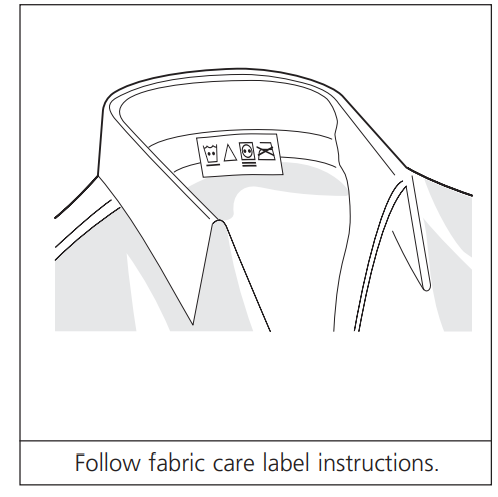
WARNING: To reduce the risk of fire, electrical shock, or serious injury to persons or property, comply with the basic warnings listed in Important Safety Instructions and those listed below.
- Prepare items for drying.
• Dry items of similar fabric, weight and construction in the same load.
• Separate dark items from light-colored items. Separate items that shed lint from those that attract lint. If an item sheds lint, turn it inside out.
• Be sure buckles, buttons and trim are heatproof and won't damage the drum finish. Close zippers, fasten hooks and Velcro®-like fasteners. Tie strings and sashes to prevent snagging and tangling.
• If possible, turn pockets inside out for even drying.
• Check for stains which may not have been removed in washing. Dryer heat may permanently set some stains. Repeat stain removal process before drying.
• Place small items in a mesh bag to prevent tangling and for easy removal.
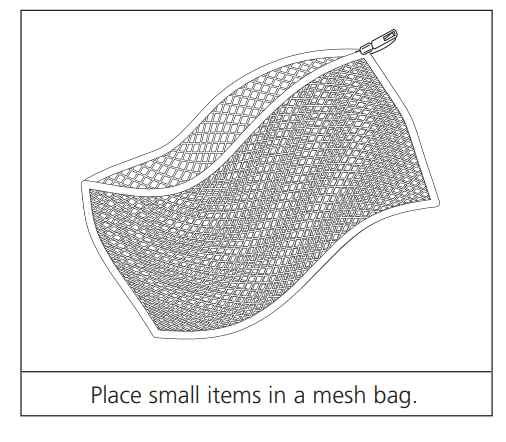
- Check that lint screen is clean and in place.
- Load the dryer.
• The average load will fill the drum 1/3 to 1/2 full. Items need room to tumble freely for even drying and less wrinkling. Do not overload dryer.
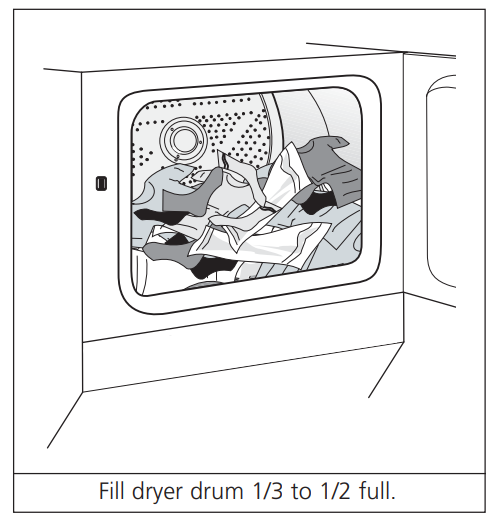
• When drying large items, dry only 2 or 3 at a time. Fill out the load with small and medium sized items.
• For delicate or very small loads, add 2 lint-free towels for better drying, less wrinkling, and to prevent grease stains caused by fabric softener sheets.
• Do not overdry items. Overdrying can cause wrinkling, shrinkage, harshness, and a build-up of static electricity, which can produce more lint.
• If desired, add a dryer fabric softener sheet. - Close the dryer door and set dryer controls (some models). See Dryer Operating Instructions card for your specific model controls.
- Select cycle and settings according to type of load, level of dryness and/or options desired.
- Start the dryer.
• Turn Start control clockwise to ON. Hold for 1-2 seconds and release.
• To add or remove items when the dryer is running, open the door. The dryer will always stop when the door is opened.
• Allow the drum to come to a complete stop before reaching inside. - When the cycle ends, remove items immediately and hang or fold. If load is removed before the cycle ends, turn cycle selector to OFF.
Features
Cycle Signal Control (some models)
When the Cycle Signal Control is ON, a signal will sound at the end of each cycle and during the Press Saver setting (some models). The volume is adjustable on some models.
Drum Light (some models)
A drum light will come on whenever the door is opened to illuminate the dryer drum during loading and unloading. Closing the door turns off the light.
Drying Rack (some models)
Use the drying rack to dry items which should not be tumble dried.
- Open the dryer door and remove the lint screen.
- Insert drying rack into the dryer drum. Place the front bar under the lip of the lint screen opening.
- Place items to be dried on top of rack. Weight should not exceed 10 lbs. Leave space between items, but do not let items hang over the sides or through the grids. Do not tumble other items when using the drying rack.
- Select a timed dry setting best suited for items being dried. Use only the Air Fluff (no heat) temperature setting for items containing plastic, foam rubber, rubber-like materials, feathers or down.
- When items are dry, remove the rack and replace the lint screen. If lint screen is not in place, tumbling items could enter the exhaust system and cause damage to the dryer.

Common Drying Problems
Many drying problems involve poor cleaning results, poor soil and stain removal, residues of lint and scum, and fabric damage. For satisfactory drying results, follow these suggestions provided by The Soap and Detergent Association.
| PROBLEM | POSSIBLE CAUSES | SOLUTIONS | PREVENTIVE MEASURES |
| Greasy, oily stains |
|
|
|
| Lint |
|
|
|
| Pilling (Fibers break off, ball up and cling to fabric.) |
|
|
|
| Shrinking |
|
|
|
| Wrinkling |
|
|
|
Care and Cleaning
WARNING: To reduce risk of fire or serious injury to persons or property, comply with the basic warnings listed in Important Safety Instructions and those listed below.
- Before cleaning the washer or dryer interior, unplug the electrical power cord to avoid electrical shock hazards.
- Do not use any type spray cleanser when cleaning dryer interior. Hazardous fumes or electrical shock could occur.
Inside the Washer
- Remove items from the washer as soon as the cycle ends. Excess wrinkling, color transfer, and odors may develop in items left in the washer.
- Dry the washer top, the area around the lid opening, and the underside of the lid. These areas should always be dry before the lid is closed.
- Before cleaning the washer interior, unplug the electrical power cord to avoid electrical shock hazards.
- When extremely soiled items have been washed, a dirty residue may remain on the tub. Remove this by wiping the tub with a nonabrasive household cleanser. Rinse thoroughly with water.
- The agitator or tub may become stained from fabric dye. Clean these parts with a nonabrasive household cleanser. This prevents dye transfer to future loads.
Inside the Dryer
- Clean the dryer lint screen after every load. Lint build-up in the screen restricts air flow, which causes longer drying times. The screen is located at the bottom of the door opening. Remove by pulling straight up. Remove the lint and replace the screen.
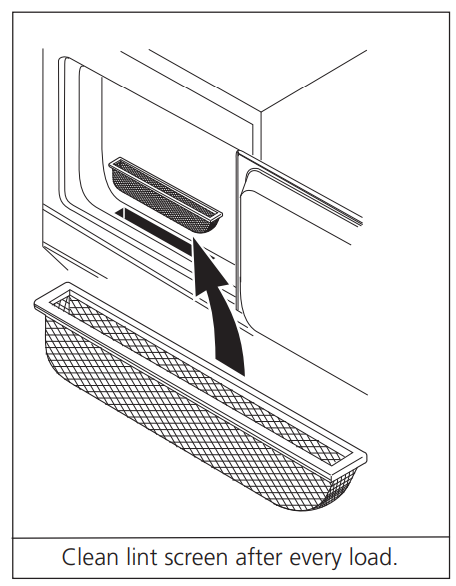
- Occasionally a waxy build-up may form on the lint screen from using dryeradded fabric softener sheets. To remove this build-up, wash the lint screen in warm, soapy water. Dry thoroughly and replace. Do not operate the dryer without the lint screen in place.
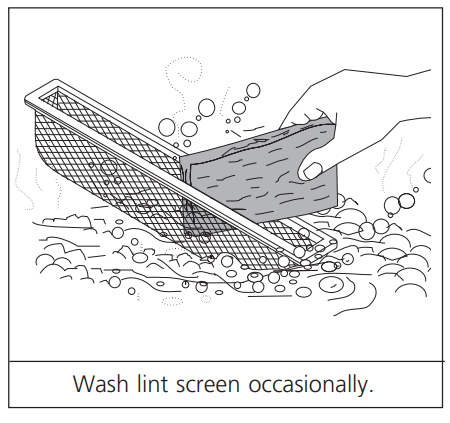
- If the dryer drum becomes stained from noncolorfast fabrics, clean the drum with a damp cloth and a mild liquid household cleanser. Remove cleanser residue before drying the next load.
- Every 18 months a Sears or other qualified service dealer should clean the dryer cabinet interior and exhaust duct. These areas can collect lint and dust over time. An excessive amount of lint build-up could result in inefficient drying and possible fire hazard.
Outside
- When laundering is completed, wipe cabinet with a damp cloth. Turn water faucets off to prevent pressure build-up in the hoses.
- Clean the cabinet with mild soap and water. Never use harsh, gritty or abrasive cleansers. If the cabinet becomes stained, clean with diluted chlorine bleach [1/2 cup (120 ml) in 1 quart (.95 L) water]. Rinse several times with clear water.
- Remove glue residue from tape or labels with a mixture of warm water and mild detergent. Or, touch residue with the sticky side of the tape or label.
- Before moving the laundry center, place a strip of cardboard or thin fiberboard under the front leveling legs to prevent floor damage.
CAUTION: Use care with laundry products. They can damage finish on the laundry center.
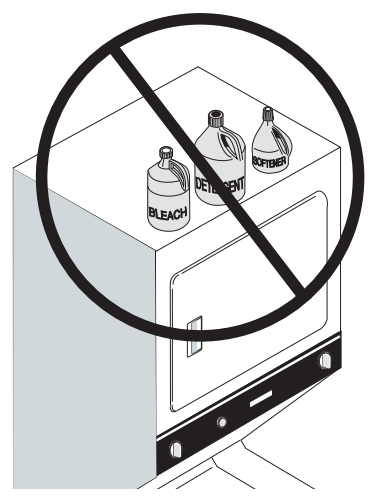
Winterizing Instructions
If the laundry center is stored in an area where freezing can occur or moved in freezing temperatures, follow these winterizing instructions to prevent damage to the laundry center:
- Turn off water supply faucets.
- Disconnect hoses from water supply and drain water from hoses.
- Plug electrical cord into a properly grounded electrical outlet.
- Add 1 gallon nontoxic recreational vehicle (RV) antifreeze to empty wash tub. Close lid.
- Set cycle selector knob at a spin setting. Pull out knob and let washer spin for 1 minute to drain out all water. Not all of the RV antifreeze will be expelled.
- Push in knob, unplug electrical power cord, dry tub interior, and close lid.
- Store washer in an upright position.
- To remove antifreeze from washer after storage, run empty washer through a complete cycle using detergent. Do not add wash load.
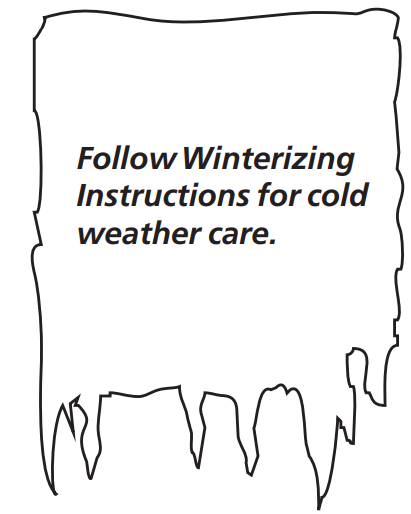
Avoid Service Checklist
Before calling for service, review this list. It may save both time and expense. The list includes common concerns that are not the result of defective workmanship or materials in this laundry center.
WASHER - NOISE
| OCCURRENCE | POSSIBLE CAUSE | SOLUTION |
| "Clunking" or gear sounds. | A certain amount of "clunking" or gear sounds are normal in a heavy-duty washer. | This is normal. |
| Rattling and clanking noise. | Foreign objects such as coins or safety pins may be in tub or pump. | Stop washer and check tub. If noise continues after washer is restarted, objects may be in pump. Call Sears or other qualified service dealer. |
| Belt buckles and metal fasteners are hitting wash tub. | To prevent unnecessary noise and damage to tub, fasten fasteners and turn items inside out. | |
| Squealing sound or hot rubber odor. | Washer is overloaded. | Do not overload washer. Stop washer and reduce load. |
| Thumping sound | Heavy wash loads may produce a thumping sound. | This is usually normal. If sound continues, washer is probably out of balance. Stop washer and redistribute wash load. |
| Vibrating noise. | Laundry center is not resting on a solid, firm floor. | Move laundry center so it rests firmly on solid floor. Additional floor bracing may be needed. Adjust leveling legs. See INSTALLATION INSTRUCTIONS for details. |
| Shipping bolt and block have not been removed during installation. | See INSTALLATION INSTRUCTIONS for removing shipping bolt and block. | |
| Wash load unevenly distributed in tub. | Stop washer and rearrange wash load |
WASHER - OPERATING
| OCCURRENCE | POSSIBLE CAUSE | SOLUTION |
| Washer does not start. | Washer lid is open | Close washer lid |
| Electrical power cord may not be plugged in or connection may be loose. | Make sure plug fits tightly in wall outlet | |
| House fuse blown, circuit breaker tripped, or a power outage has occurred. | Reset circuit breaker or replace fuse. Do not increase fuse capacity. If problem is a circuit overload, have it corrected by a qualified electrician. If problem is a power outage, call local electric company | |
| Water supply faucets are not turned on. | Turn on water supply faucets. | |
| Cycle selector is not in correct position. | Move indicator clockwise slightly. Pull out knob. | |
| Motor is overheated. | Washer motor will stop if it becomes overheated. It will automatically restart after a cool down period of up to 30 minutes (if washer has not been manually turned off). | |
| Washer won't spin. | Lid is not completely closed | Close lid completely. Safety lid lock must not be broken. |
| Residue left in tub. | Heavily soiled items | Wipe tub with a nonabrasive household cleanser, then rinse. Shake or brush excess dirt and sand from items before washing. |
WASHER - WATER
| OCCURRENCE | POSSIBLE CAUSE | SOLUTION |
| Wash load too wet after spin. | Washer is overloaded. | Do not overload washer. See Washing Procedures. |
| Load is out of balance. | Rearrange load to allow proper spinning. | |
| Drain hose is kinked. | Straighten drain hose. | |
| Water does not enter washer or it enters slowly | Lid is not completely closed. | Close lid completely. Washer will not fill with water when the lid is open. |
| Water supply is not adequate in area. | Check another faucet in the house. Wait until water supply and pressure increase. | |
| Water supply faucets are not completely open. | Fully open hot and cold faucets. | |
| Water is being used elsewhere in the house. | Water pressure must be at least 30 psi (260 kPa). Avoid running water elsewhere while washer is filling. | |
| Water inlet hoses are kinked. | Straighten hoses. | |
| Water level does not cover load. | Washer is overloaded. | Do not overload washer. When control is set at highest fill level, dry load level should not be higher than top row of circular holes in wash tub. |
| Warm or hot water is not hot enough. | Hot water heater is set too low or is a distance from laundry center. | Measure hot water temperature at nearby faucet with candy or meat thermometer. Water temperature should be at least 120°F (49°C). Adjust water heater as necessary |
| Hot water is being used elsewhere in the house. | Avoid using hot water elsewhere before or during washer use. There may not be enough hot water available for proper cleaning. If problem persists, your hot water system may be unable to support more than 1 use at a time. | |
| To conserve energy, the temperature of the hot wash is regulated. | See Operating Instructions for your washer | |
| Water in washer does not drain or drains slowly. | Drain hose is kinked or clogged. | Clean and straighten the drain hose. |
| Water leaks. | Loose fill hose connection at faucet or washer. | Check and tighten hose connections. Install rubber sealing washers provided. |
| House drain pipes are clogged. | Unclog drain pipes. Contact plumber if necessary. | |
| Oversudsing. | Use less detergent. | |
| Incorrect wash and rinse temperatures. | Hot and cold water hoses are connected to wrong supply faucets. | Connect hot water hose to hot water faucet and cold water hose to cold water faucet. |
| Water is entering washer but tub does not fill. | Drain hose standpipe is incorrect height. | Standpipe must be a minimum of 33" (83.82 cm) high to prevent siphoning. See INSTALLATION INSTRUCTIONS. |
DRYER
| OCCURRENCE | POSSIBLE CAUSE | SOLUTION |
| Dryer does not start. | Electrical power cord is not securely plugged in or plug may be loose. | Make sure the plug fits tightly in wall outlet. |
| House fuse blown or circuit breaker tripped. |
Reset circuit breaker or replace fuse. Make sure electrical line is not overloaded and the dryer is on a separate circuit. |
|
| Thermal limiter tripped. | Call a qualified service dealer for replacement. | |
| Dryer runs but won't heat. | There are 2 house fuses in the dryer circuit. If 1 of the 2 fuses is blown, the drum may turn but the heater will not operate. | Replace fuse. |
| Gas supply valve is not open (gas models). | Check to make sure supply valve is open. See INSTALLATION INSTRUCTIONS for procedure. | |
| Dryer does not have enough air supply to support the burner flame (gas models). | See INSTALLATION INSTRUCTIONS. | |
| LP gas supply tank is empty or there has been a utility interruption of natural gas (gas models). |
Refill or replace tank. Dryer should heat when utility service is restored. |
|
| Drying cycle takes too long, outside of the dryer feels too hot or smells hot. | Lint screen is clogged with lint. | Make sure all lint has been removed from the dryer lint screen before starting each cycle. |
| Exhaust duct requirements have not been met. |
Exhaust duct must be at least 4 inches in diameter and made of rigid or flexible metal. When in place, the duct must have no more than two 90° bends and must not exceed length listed in INSTALLATION INSTRUCTIONS. |
|
| Electric dryer is connected to a 208 volt circuit. | Drying time will be 20% longer than drying on a 240 volt circuit. | |
| Drying procedures have not been followed. | See Drying Procedures. | |
| Outside exhaust hood or exhaust duct may be clogged or restricted. | Clean out any obstruction | |
| Excessive wrinkling | High humidity. | Use a dehumidifier near the dryer. |
| Dryer is overloaded. | Do not overload. See Drying Procedures. | |
| Items left in dryer too long. | Remove items as soon as cycle ends. | |
| Insufficient sorting of items. | See Drying Procedures. | |
| Drying temperature too high. | Follow fabric care label instructions. |
